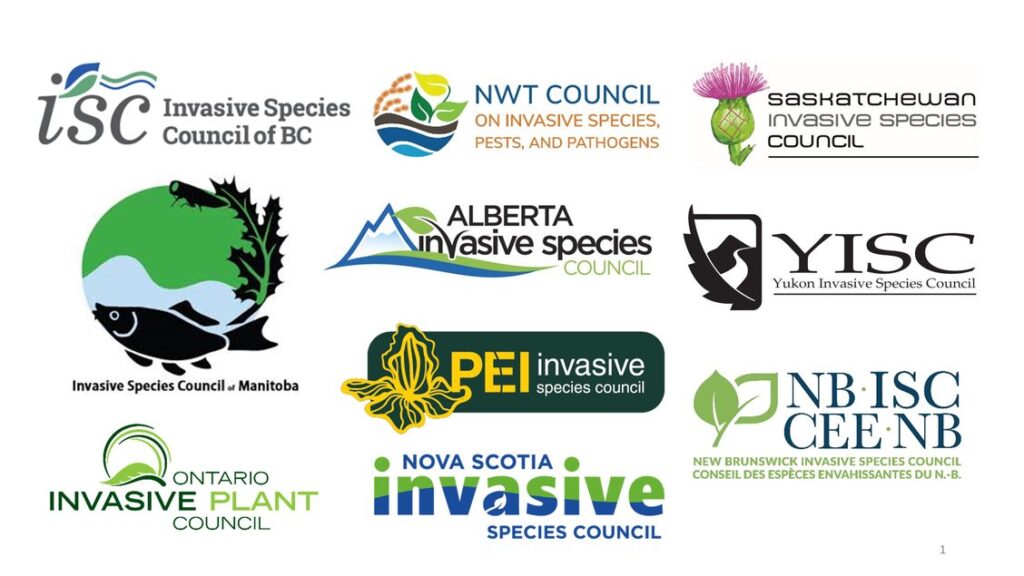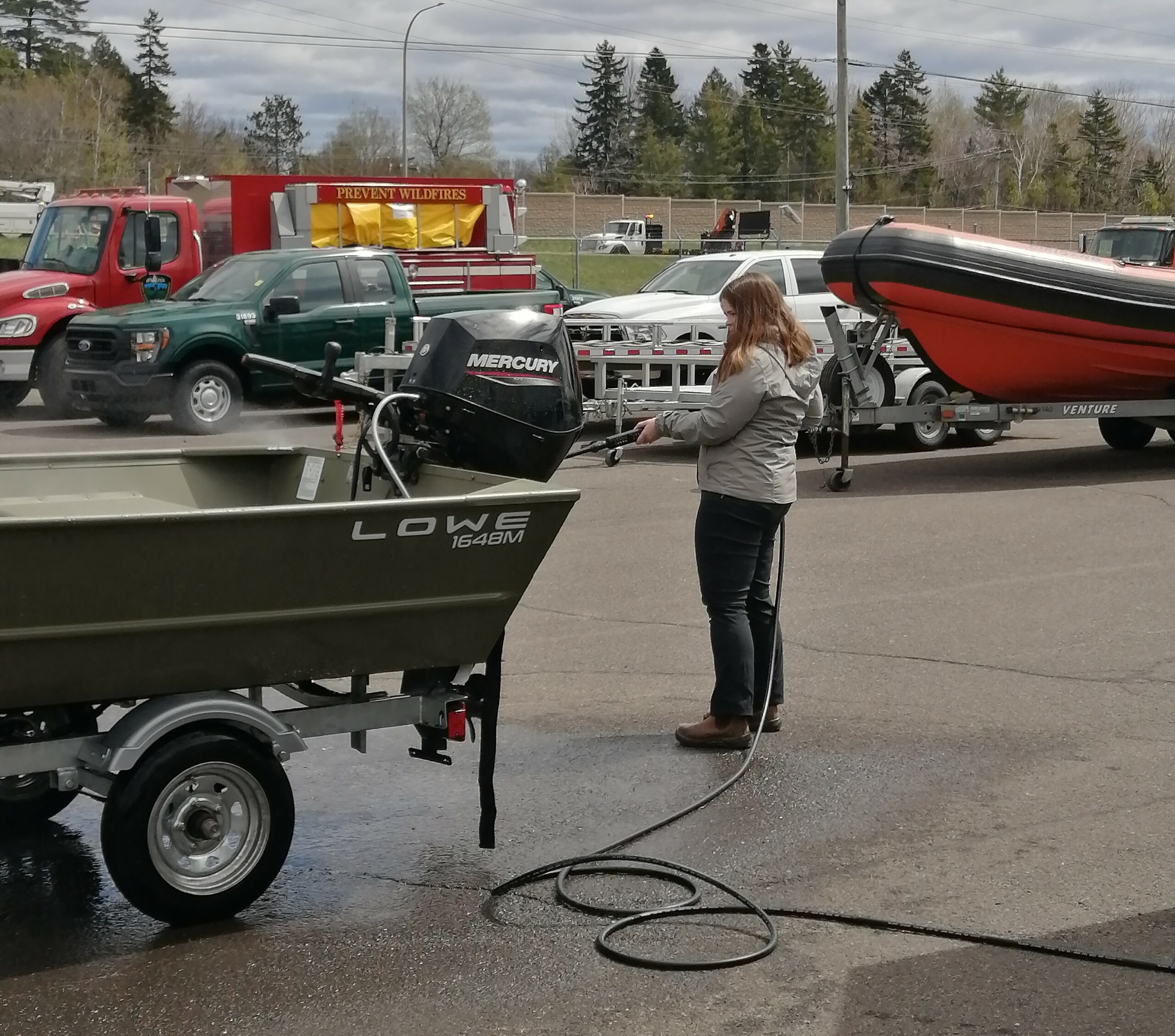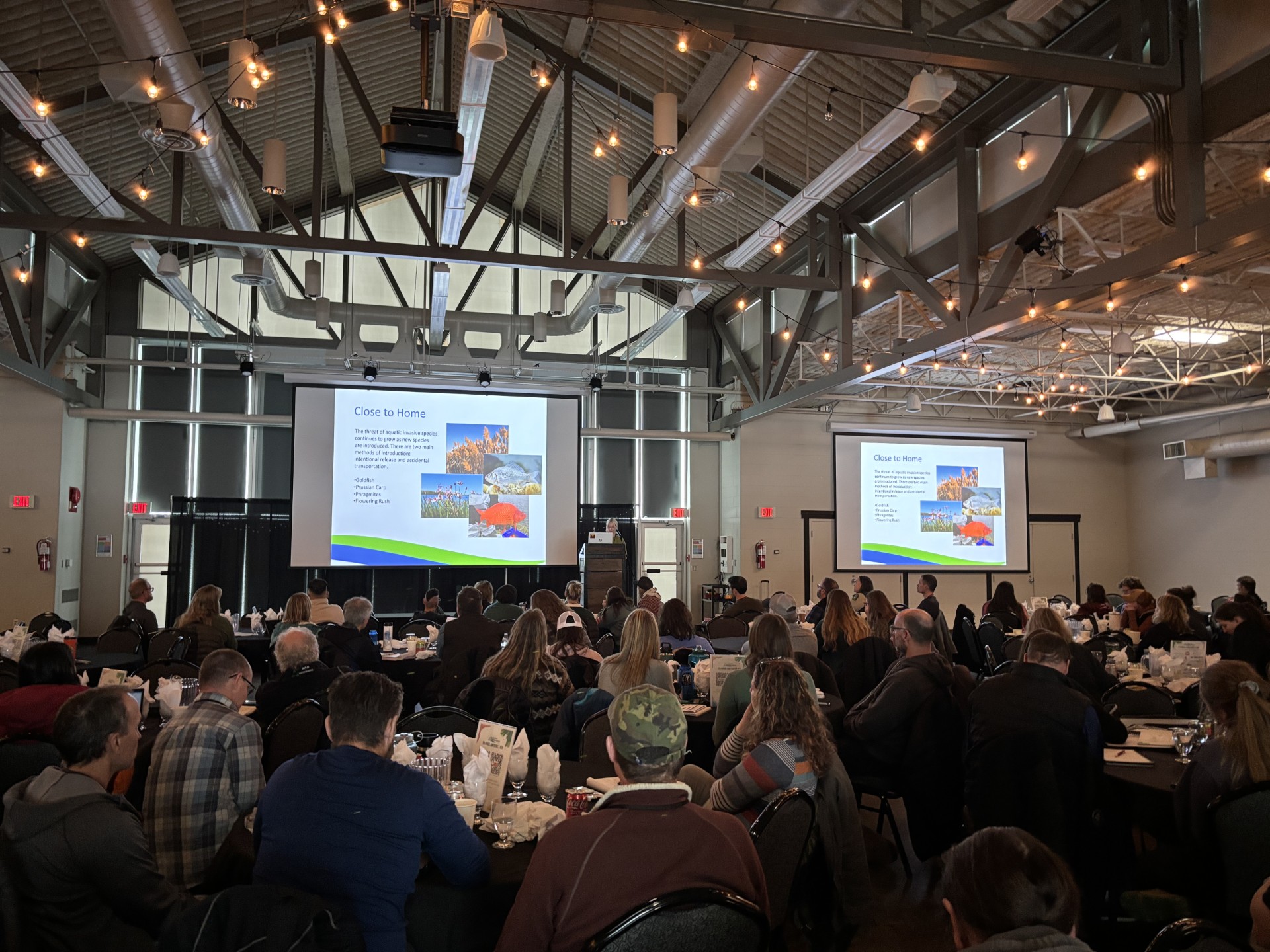CCIS Chapter Update: Spring 2024
Now that Spring is upon us and things are growing, our Chapters have been busy continuing their amazing work and returning to the field!
Continue reading for updates on the work our Chapters have been engaged in the past few months.
The Canadian Council on Invasive Species has established a strong network of chapters spanning across Canada, from coast to coast. Each of our 10 chapters is a provincial or territorial invasive species organization with a unique structure and mandate. They work together to create partnerships and address local issues while ensuring consistent messaging and resources to help Canadians take responsible actions.
Our Chapters include:
- Alberta Invasive Species Council
- Invasive Species Council of BC
- Invasive Species Council of Manitoba
- New Brunswick Invasive Species Council
- Northwest Territories Council on Invasive Species, Pests and Pathogens
- Nova Scotia Invasive Species Council
- Ontario Invasive Plant Council
- Prince Edward Island Invasive Species Council
- Saskatchewan Invasive Species Council
- Yukon Invasive Species Council

Here’s an update from some of our Chapters:
Prince Edward Island Invasive Species Council
Field work has begun on PEI!

- Shovels have hit the ground at the main site of the giant hogweed eradication project. A pre-management survey has shown great results from last year’s efforts.
- Garlic mustard management has started at a few sites. Unfortunately, 3 new small invaded sites have been discovered this year.
- 15 eDNA traps have been set up in high priority hemlock stands across PEI in an effort to detect the potential arrival of hemlock woolly adelgid.
- The PEIISC partnered with the City of Charlottetown and the PEI School Board to remove glossy buckthorn from an urban natural area with the help of 100+ high school students.
Ontario Invasive Plant Council
Past Events:
- Grow Me Instead – Promoting Invasive-free Gardening Across Ontario Webinar (April 18th, 2024) which saw over 200 attendees and is the most well attended OIPC webinar to date. The recording is available to watch on our YouTube channel: https://youtu.be/OURS30yv0Tc
- An Introduction to Invasive Plants (May 16th, 2024 and May 23rd, 2024).
New and Upcoming Resources
- Japanese Barberry Best Management Practices funded by Environment and Climate Change Canada. This document can be viewed for FREE on our website: https://www.ontarioinvasiveplants.ca/invasive-plants/species/japanese-barberry/
- Two NEW Best Management Practices are in the final stages, sent for desktop publishing:
- Burdock Best Management Practices (includes common burdock, greater burdock, woolly burdock)
- Manitoba Maple Best Management Practices
- Two NEW Best Management Practices are undergoing updates to several sections:
- Oriental Bittersweet Best Management Practices
- Winged Euonymus Best Management Practices
Upcoming Events
- OIPC Spring/Summer Webinars – Registration details will be posted here as they become available: https://www.ontarioinvasiveplants.ca/events.
- An Introduction to Aquatic Invasive Plants – June 20th, 2024 12:00pm – 1:30pm EST
-
- This 1.5 hr session will cover the biology, life cycle, habitat, pathways of spread, identification characteristics and impacts of several invasive aquatic plants that have negative impacts on Ontario’s environment, economy and society (Eligible for Continuing Education).
- An Introduction to Woody Invasive Plants – July 18th, 2024 12:00pm – 1:30pm EST
-
- This 1.5 hr session will cover the biology, life cycle, habitat, pathways of spread, identification characteristics and impacts of several invasive woody plants that have negative impacts on Ontario’s environment, economy and society (Eligible for Continuing Education).
- Emerging Invasive Pests in Ontario – August 29th, 2024 12:00pm – 1:45pm EST
-
- In this 1hr 45mins session, participants will be introduced to three emerging invasive species in Ontario (Oak Wilt, Hemlock Woolly Adelgid and Spotted Lanternfly) and learn about identification, biology and life cycle, pathways of spread and impacts. This session will also feature a 45-minute guest speaker panel (15 minutes per species) with a 15-minute Q&A at the end (Eligible for Continuing Education).
Nova Scotia Invasive Species Council
Events:
- Our entire team attended the 2024 International Conference on Aquatic Invasive Species, held in our backyard, Halifax, Nova Scotia. We presented on Behaviour Change programs and spoke with people from around the world at our trade show booth.
- We have enjoyed conducting walking tours and speaking at many events across the province. It is great to see the enthusiasm when people talk about stopping invasive species.
Training:
- OZero, the manufacturers of our Boat Decontamination Station, provided training on how to use and maintain it. We were pleased to have staff from DFO join us
- We attended eDNA training so we can search for Zebra Mussels this summer
- All staff have updated their First Aid certification through St. John Ambulance
Data:
- We are analyzing water quality data to determine lakes and rivers with the potential to support Zebra Mussel populations so we can build an effective monitoring program to be implemented this year
- Our 2024 survey of Nova Scotians found substantial increases in recognition of our programs since we last surveyed in 2022, showing that our community outreach program has worked well.
Community Outreach:
- Subscriptions to our popular quarterly newsletter are climbing quickly. You can sign up for our newsletter at nsinvasives.ca. While there, look for information on the invasive species you are interested in, download our free publications, and feel free to hit the donate button if you would like to support out work.
- Shubie Park was a nice spot to participate in a video shoot for an upcoming project on aquatic invasive species.
- CBC’s Maritime Noon phone-in show was kind enough to invite us in. The podcast is online. (You can scrub to the 12 minute mark where the invasive species starts, or listen from the start to also hear a very informative piece on shark safety in Nova Scotia.)
New Brunswick Invasive Species Council
New resources: 
- Quad Sticker for Play Clean Go
- Buy Local Burn Local poster
- New Zebra Mussel project landing page
Updates on Projects:
- We launched our bilingual Zebra Mussel and Clean Drain Dry video campaign on Facebook, Instagram, and YouTube, which has been seen by over 43,000 individuals across New Brunswick and Quebec to date.
- Continued to work with nurseries and garden-related businesses across province to distribute info about Plant Wise.
- We have been working with partners to organize summer monitoring efforts. This summer our on-the-ground projects include:
- Collaborating with CFIA to procure EAB prism traps, and with partners to install and monitor the traps over the summer.
- Working with DFO and regional partners to identify sites for Zebra Mussel monitoring with eDNA testing, veliger sampling, and settlement plates, and to divide responsibilities.
- Consulting a herpetology professor to develop video monitoring for potential red-eared slider
- Working with watershed/lake associations to increase general IAS reporting to iMap. We have a training on species ID and another on iMap for partners on this project coming up in June.
- We completed year-end reporting for 3 of our projects
Upcoming and Recently Attended Events:
- Quad NB AGM- presentation/guest speakers – April 27th
- Miramichi Striper Cup – May 24-25th –(partnered with DFO who operated mobile boat wash; NBISC– outreach and survey distribution)
- Scouts Bioblitz at O’Dell Park – June 4th
- IAS ID training – June 6th
- CDD presentation to Fredericton Fish and Game – June 11th
- Plant Wise – Presentation to River Valley Garden Club – June 13th
- Plant Wise – EarthFest at Minister’s Island (info booth and activities) – June 16th
- Site visit to Fundy National Park (managing invasive species in the park with Resource Manager, Neil Vinson) – June 17th
- ZM info session to the City of Fredericton – July 3rd
Other:
- Delivered IAS training to the Department of Infrastructure and Transportation in Fredericton – April 17th
- Drafted a summary report from the EAB workshop to be used by CFIA to determine next steps for EAB management in Eastern Canada
- We attended multiple conferences.
- April 10th-12th Kristin and Clarissa attended the Maine Invasive Species Network annual meeting in Orono, ME.
- May 7th-9th the whole staff attended the CCIS Strategic Planning meeting in Toronto.
- May 13th-16th Kristin and Clarissa attended the International Conference on Aquatic Invasive Species in Halifax.
Invasive Species Council of British Columbia
Invasive Species Action Month:
- Every year the province of B.C. proclaims May Invasive Species Action Month (ISAM). This year, we brought it back to basics: identifying, reporting, managing, and preventing the spread of invasive species. Providing important new information for some and a great reminder for everyone! ISAM created quite the buzz, generating 31 unique media reports on invasive species issues. We also hosted five informative webinars and introduced some awesome new swag, including new stickers and an invasive species poster.
Virtual Pesticide Applicator Certification Course:
- In April, we hosted 24 participants for an online, virtual program led by ISCBC instructors. The training reflected actual field-type situations offering participants training closer to hands-on practical experience. The course reached capacity, and with so much interest, we scheduled another session for June 11-13. Register for the course HERE.
New Invasive Species Education Kit:
- ISCBC now has several of our Invasive-Wise resources as part of an Invasive Species Education Kit, for sale on the Outdoor Learning School & Store’s website. The kit helps educators across North America teach about and offer ways to help manage invasive species! Check out the link HERE.
Join the Celebration in 2025:
- Next year marks the 20th anniversary of our Annual AGM & Forum. Save the date for INVASIVES 2025 in New Westminster, B.C., February 24-27, 2025, and join us in celebrating 20 years of sharing knowledge and building community.
- The excitement continues with the return of the Invasive Species Research Conference on May 13-15, 2025, in Kelowna, B.C. Researchers and practitioners across the Pacific Northwest and beyond will gather to share the latest advancements and discoveries in invasive species research.
Alberta Invasive Species Council
11th Annual Conference and AGM:

- The Annual Conference of the Alberta Invasive Species Council (AISC) held in March, drew 240 attendees passionate about combatting invasive species.
- This year’s event featured a diverse array of educational sessions aimed at fulfilling AISC’s mission to raise awareness and educate Albertans about the detrimental effects of invasive species on the environment, economy, and society.
- Attendees had the opportunity to engage with 15 research posters from students, practitioners and researchers, as well as earn 7 pesticide applicator credits and 7 Certified Crop Advisor (CEUs) credits from the sessions, underscoring the professional development aspect of the conference.
- The conference program boasted 18 expert speakers covering various topics including discussions on the ecological impact of wild boars, the complexities of managing Dutch elm disease and innovative biocontrol methods, cutting-edge techniques such as environmental DNA (eDNA) detection for invasive species monitoring, and regional updates.
Upcoming Webinar:
- On June 13th we will be hosting a FREE webinar to discuss the latest IPBES report from the two keynote speakers at our conference: Nicole Kimmel, Aquatic Invasive Species Specialist with Alberta Environment and Protected Areas and Dr. Patrick Hanington, Associate Professor, School of Public Health with the University of Alberta. Register for the webinar HERE.
New Resources:
- We created a new factsheet on feral rabbits, which adds to over 150 factsheets for the AISC. You can find the factsheet HERE.
Saskatchewan Invasive Species Council
2024 field season right around the corner!
- Continuing our Flowering Rush work in Saskatchewan. Our plan is to survey the South Saskatchewan River from the Alberta border to Saskatchewan Landing Provincial Park, a distance of well over 100 km.
- Plans to remove a large section of entrenched Flowering Rush near the Alberta border and will once again work with the Alberta Invasive Species Council and its partners to tackle this cross-border issue.
- In the Cutarm Creek system, we will monitor Flowering Rush populations that have been treated with herbicide, while in the Cutarm Reservoir we will hopefully eradicate the remaining population.
- For the first time, we will also survey the Gainsborough Creek to determine the extent of a Flowering Rush occurrence that was found late in 2023.
New Resources:
- We have released fact sheets for every species on the Saskatchewan Weed Control Act. You can find our fact sheets HERE.